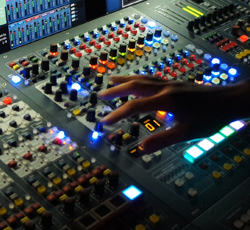A while back, I got the rare opportunity to work with the youth band at our church. These guys have an incredible heart and passion to worship and have loads of raw talent which translates into a powerful time of worship.
When they lead, as a worshipper I feel free and emboldened to praise God the way He created me too. When they lead, as a sound operator I have to work as hard and quick as ever to create a decent mix to help facilitate that worship.
More Compressors Please
As is the case with most youth bands and even many churches, they’re not using state of the art or high dollar gear for their services. Now don’t get me wrong, they’re not operating with the bare minimum. The system includes an Allen & Heath console, JBL loudspeakers and subwoofers, and solid system and signal processing. But what I longed for that night was individual compressors.
Keeping The Vocals On Top
Maybe this never happens to you, but in a mix including three vocals, an un-caged drum set, two electric guitars, acoustic, bass, and keyboard, I had a hard time keeping the vocals out on top to lead the group in worship while keeping the music strong.
The vocalists on the team are gifted in leading worship, but for a variety of reasons (key of the song, dynamic range, mic etiquette, etc) their volumes were all over the place that night. and the second I took my finger off their faders I would either lose them or have way too much of them. With seven stage monitors, acoustic drums, three amps and a very small stage, I was dreaming of a few compressors to help me layer the mix the way I wanted.
Most Useful Tool
The compressor is one of the sound operator’s most useful tools—yet I’m always surprised how few people seem to understand and know how to effectively use this critical piece of gear.
What Is Compression, Really?
The clearest definition of compression that I’ve ever seen is this: “Compression is the art of making louder parts of a composition appear softer, and conversely, the softer parts appear louder.”
That night, if I would have left the lead singer’s fader in one spot for the entire night, his volume alone would have ranged anywhere from 85 dB to 120 dB. All right, that might be an exaggeration, but he got loud. When he was closer to the 85-95 dB volume, he could barely be heard over the drums and guitars. Neither end of the spectrum is really acceptable in a good mix, so compression comes along and makes it possible to narrow down that volume range to make things more mixable.
How A Compressor Works
Let’s say I have a 20 dB of range between a vocalist’s quiet singing versus his loudest singing. With a compressor, I can take that 20 dB range and make it as small as a 1 dB range, but since I don’t want to eliminate the artistic dynamic range that singers use to create the mood or feel of what they’re singing, I can get that range down to a very manageable 5-8 dB that will make mixing significantly less complicated but still leave some of that dynamic in place.
So how do we get our compressor to do that? With some understanding of the compressor’s settings you can be on your way to a smoother sound and a less stressful time behind the board.
Control Elements
Threshold. In simple terms the threshold is the point where the compressor starts to do its thing. Since there is a wide range of compressor and mixer brands, I’m going to talk about these settings more generically as opposed to using the numbers on the knob. If the input meter on your console (let’s say negative infinity to +15 dB) matches that of your compressor, things will be a little clearer as the numbers will match.
You must first set the gain (or trim) of your channel on your mixer (on my regular console that is around +3, or typically where the green lights first turn to yellow or maybe the yellow light just starts to glow on the meter).
Now if your numbers match, and your vocal meter is showing signal between -5 and +10 dB, I’d start with my threshold set close to 0 dB. If your numbers don’t match, once your gain is set turn your threshold knob and find the area where the gain reduction knobs just come on. Begin with your threshold there, and if you find it’s not compressing frequently or soon enough, you can lower the threshold from there to make it kick in sooner.





















